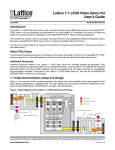Download FPD-Link Evaluation Kit User`s Manual
Transcript
FPD-Link Evaluation Kit User’s Manual FPD-Link Evaluation Kit User’s Manual NSID FLINK3V8BT-85 Rev 3.0 National Semiconductor Corporation Rev 3.0 Date: 9/25/2007 Page 1 of 25 FPD-Link Evaluation Kit User’s Manual Table of Contents INTRODUCTION .............................................................................................................. 3 CONTENTS OF EVALUATION KIT................................................................................. 4 APPLICATIONS ............................................................................................................... 4 FEATURES AND EXPLANATIONS .................................................................................. TRANSMITTER .................................................................................................................. 7 RECEIVER ..................................................................................................................... 12 HOW TO HOOK UP THE DEMO BOARDS (OVERVIEW) ............................................. 6 TRANSMITTER BOARD.................................................................................................. 7 SELECTABLE JUMPER SETTINGS FOR THE TX BOARD ......................................................... 8 LVDS MAPPING BY IDC CONNECTOR ............................................................................... 9 TX OPTIONAL: PARALLEL TERMINATION FOR TXIN .......................................................... 10 BOM (BILL OF MATERIALS) ............................................................................................ 11 RECEIVER BOARD ....................................................................................................... 12 SELECTABLE JUMPER SETTINGS FOR THE RX BOARD....................................................... 13 LVDS MAPPING BY IDC CONNECTOR ............................................................................. 14 RX OPTIONAL: SERIES TERMINATION FOR RXOUT .......................................................... 15 BOM (BILL OF MATERIALS) ............................................................................................ 16 TYPICAL CONNECTION / TEST EQUIPMENT ............................................................ 17 TYPICAL WAVESHAPES .................................................................................................. 19 TROUBLESHOOTING ................................................................................................... 21 ADDITIONAL INFORMATION ....................................................................................... 22 APPLICATION NOTES ...................................................................................................... 22 APPENDIX...................................................................................................................... 23 TRANSMITTER AND RECEIVER SCHEMATICS..................................................................... 24 National Semiconductor Corporation Rev 3.0 Date: 9/25/2007 Page 2 of 25 FPD-Link Evaluation Kit User’s Manual Introduction: National Semiconductor - Interface Products Group FPD-Link evaluation kit contains a Transmitter (Tx) board, a Receiver (Rx) board along with interfacing cables. This kit will demonstrate the DS90C385A/DS90CF386 chipsets interfacing from test equipment or a graphics controller using Low Voltage Differential Signaling (LVDS) to a receiver board. The Transmitter board accepts LVTTL/LVCMOS RGB signals from the graphics controller along with the clock signal. The LVDS Transmitter converts the LVTTL/LVCMOS parallel lines into four serialized LVDS data pairs plus a LVDS clock. The serial data streams toggle at 3.5 times the clock rate. The Receiver board accepts the LVDS serialized data streams plus clock and converts the data back into parallel LVTTL/LVCMOS RGB signals and clock for the panel timing controller. The user needs to provide the proper RGB inputs and clock to the Transmitter and also provide a proper interface from the Receiver output to the panel timing controller or test equipment. A cable conversion board or harness scramble may be necessary depending on type of cable/connector interface used. A power down feature is also provided that reduces current draw when the link is not required. National Semiconductor Corporation Rev 3.0 Date: 9/25/2007 Page 3 of 25 FPD-Link Evaluation Kit User’s Manual Contents of the Evaluation Kit: 1) One Transmitter board with the DS90C385AMTD - 28 bit Transmitter 2) One Receiver board with the DS90CF386MTD - 28 bit Receiver 3) One 20-pin IDC Flat Ribbon Cable 4) One 60-pin IDC Flat Ribbon Cable 5) Evaluation Kit Documentation (this manual) 6) DS90C385A/DS90CF386 Datasheet 7) LVDS Owner’s Manual (2nd Edition) FPD-Link Typical Application: DATA (LVDS) HOST GRAPHICS CONTROLLER LVCMOS/ LVTTL LVCMOS/ LVTTL LCD PANEL CONTROLLER CLOCK (LVDS) FPSHIFT OUT (TxCLK IN) FPSHIFT OUT (RxCLK OUT) DS90C385A DS90CF386 FPD-Link Application LVDS 28 DS90CF386 FPD Link 5 Pairs FPD Link Tx Cable Rx CLK Notebook Computer Motherboard Column Drivers 28 Row Drivers Graphic Controller Interface e.g, PCI Bus DS90C385A LVCMOS/LVTTL Timing Controller LVCMOS/LVTTL TFT-LCD Display GND Notebook Hinge Notebook Computer Display Typical FPD-Link Application (24-bit Color) The diagrams above illustrate the use of the Chipset (Tx/Rx) in a Host to LCD Panel Interface. National Semiconductor Corporation Rev 3.0 Date: 9/25/2007 Page 4 of 25 FPD-Link Evaluation Kit User’s Manual Chipsets support up to 18-bit or 24-bit AM-TFT LCD Panels for any VGA (640X480), SVGA (800X600), XGA (1024X768), and Single/Dual Pixel SXGA (1280X1024) resolutions. Because of the non-periodic nature of STN-DD SHFCLK, the Chipset may not work with all D-STN panels. The PLL CLK input of the Transmitter requires a free running periodic SHFCLK. Most Graphics Controller can provide a separate pin with a free running clock. In this case the STN-DD SHFCLK can be sent as Data while the free running clock can be used as SHFCLK for the PLL ref CLK. For example, C&T's 65550's WEC (Pin 102) can be programmed to provide a free running clock using the BMP (Bios Modification Program). Please refer to STN Application using (AN1056) for more information on STN support. Refer to the proper datasheet information on Chipsets (Tx/Rx) provided on each board for more detailed information. National Semiconductor Corporation Rev 3.0 Date: 9/25/2007 Page 5 of 25 FPD-Link Evaluation Kit User’s Manual How to set up the Evaluation Kit: The PCB routing for the Tx input pins (TxIN) have been laid out to accept incoming data from a 60-pin IDC connector. The TxOUT/RxIN interface uses a 20-pin IDC connector through a IDC ribbon cable. Please follow these steps to set up the evaluation kit for bench testing and performance measurements: 1) Connect one end of the 20-pin IDC cable to the transmitter board and the other end to the receiver board. Longer lengths can be used. Note: Previous HSL Tx/Rx 8 Bit boards have different IDC pinouts and must be scrambled in the IDC cable in order to be compatible with this demo kit. 2) Jumpers have been configured at the factory, they should not require any changes for operation of the chipset. See text on Jumper settings for more details. 3) From the Graphics card, connect a flat (ribbon) cable to the transmitter board and connect the another flat cable from the receiver board to the panel (Note: Refer to AN-1127 for suggested mapping schemes). Note that pin 1 on the connector should be connected to pin 1 of the cable. A scramble cable may be required. 4) Power for the Tx and Rx boards must be supplied externally through TP1 (Vcc). Grounds for both boards are connected through TP2 (GND) (see section below). Power Connection: The Transmitter and Receiver boards must be powered by supplying power externally through TP1 (Vcc) and TP2 (GND) on EACH board. The maximum voltage that should ever be applied to the FPD-Link Transmitter (385A) or Receiver (386) Vcc terminal is +4V MAXIMUM. National Semiconductor Corporation Rev 3.0 Date: 9/25/2007 Page 6 of 25 FPD-Link Evaluation Kit User’s Manual FPD-Link Transmitter Board Description: J1 (60 position) accepts 28 bit LVTTL/LVCMOS data along with the clock. The FPD-Link Transmitter board is powered externally. For the transmitter to be operational, the Power Down pin must be set HIGH with a jumper. Rising or falling edge reference clock is selected by JP1 tied to Vcc (rising) or GND (falling). The 20-pin IDC connector (J2) provides the interface for LVDS signals for the Receiver board. Note: Previous HSL Tx/Rx 8 Bit boards have different IDC pinouts and must be scrambled in the IDC cable in order to be compatible with this demo kit. 60-pin IDC Connector 1 2 GND GND GND GND GND GND GND GND GND GND GND GND GND GND GND GND GND GND GND GND GND GND GND GND GND GND GND GND GND GND TXIN0 TXIN1 TXIN2 TXIN3 TXIN4 TXIN5 TXIN6 TXIN7 TXIN8 TXIN9 TXIN10 TXIN11 TXIN12 TXIN13 TXIN14 TXIN15 TXIN16 TXIN17 TXIN18 TXIN19 TXIN20 TXIN21 TXIN22 TXIN23 TXIN24 TXIN25 TXIN26 TXIN27 Vcc and Gnd MUST be applied externally here TxOUT LVDS signals 20-pin IDC connector 1 2 OUT0GND OUT1GND OUT2GND CLKGND OUT3GND GND OUT0+ GND OUT1+ GND OUT2+ GND CLK+ GND OUT3+ 19 20 J2 Note: Previous HSL Tx/Rx 8 Bit boards have different IDC pinouts and must be scrambled in the IDC cable in order to be compatible with this demo kit. TXCLKIN GND 59 60 J1 R_FB /PD National Semiconductor Corporation Rev 3.0 Date: 9/25/2007 Page 7 of 25 FPD-Link Evaluation Kit User’s Manual Jumper Settings for the Tx Board Jumper Purpose Settings R_FB (JP1) Rising or Falling Data Strobe Vcc = Rising GND = Falling Vcc GND Default setting is JP1 set LOW (to GND), falling edge strobe. /PD (JP2) PowerDown = ON Vcc GND (ON: Tx is operational; = OFF Vcc GND OFF: Tx powers down) Default setting is JP2 set HIGH (to Vcc), operational mode. National Semiconductor Corporation Rev 3.0 Date: 9/25/2007 Page 8 of 25 FPD-Link Evaluation Kit User’s Manual Tx LVDS Mapping by IDC Connector The following two figures illustrate how the Tx inputs are mapped to the IDC connector (J1) (Note – labels are also printed on the demo boards). The 20-pin IDC (J2) connector pinout is also shown. (Transmitter Board) 60-pin IDC Connector Pin 1 59 GND GND GND GND GND GND GND GND GND GND GND GND GND GND GND GND GND GND GND GND GND GND GND GND GND GND GND GND GND GND TXIN0 TXIN1 TXIN2 TXIN3 TXIN4 TXIN5 TXIN6 TXIN7 TXIN8 TXIN9 TXIN10 TXIN11 TXIN12 TXIN13 TXIN14 TXIN15 TXIN16 TXIN17 TXIN18 TXIN19 TXIN20 TXIN21 TXIN22 TXIN23 TXIN24 TXIN25 TXIN26 TXIN27 TxOUT LVDS signals 20-pin IDC connector 2 Pin 1 TXOUT0 TXOUT0 TXOUT1 19 GND OUT0+ GND OUT1+ GND OUT2+ GND CLK+ GND OUT3+ OUT0GND OUT1GND OUT2GND CLKGND OUT3GND 20 2 J2 TXOUT1 TXOUT3 TXOUT1 TXOUT2 TXOUT2 TXCLKIN GND 60 J1 TXCLKOUT Previous Cycle Next Cycle TXOUT3 TXIN23 TXIN17 TXIN16 TXIN11 TXIN10 TXIN5 TXIN27 TXOUT2 TXIN26 TXIN25 TXIN24 TXIN22 TXIN21 TXIN20 TXIN19 TXOUT1 TXIN18 TXIN15 TXIN14 TXIN13 TXIN12 TXIN9 TXIN8 TXOUT0 TXIN7 TXIN6 TXIN4 TXIN3 TXIN2 TXIN1 TXIN0 Parallel LVTTL/LVCMOS Data Inputs Mapped to LVDS Outputs National Semiconductor Corporation Rev 3.0 Date: 9/25/2007 Page 9 of 25 FPD-Link Evaluation Kit User’s Manual Tx Board Options: 50 Ohm Termination for TxIN On the Tx demo board, the 29 inputs have an option for 50 Ohm terminations. There are 0402 pads for this purpose. One side is connected to the signal line and the other side is tied to ground. These pads are unpopulated from the factory but are provided if the user needs to install a 50 Ohm termination. R1 TO R28 are associated with the Tx data input lines. R29 is associated with CLKIN. Some test equipment may require a 50 Ohm load. Mapping of Transmitter Inputs for the Optional Termination Resistors is shown below: Tx Pin Names TxIN0 TxIN1 TxIN2 TxIN3 TxIN4 TxIN5 TxIN6 TxIN7 TxIN8 TxIN9 TxIN10 TxIN11 TxIN12 TxIN13 TxIN14 TxIN15 TxIN16 TxIN17 TxIN18 TxIN19 TxIN20 TxIN21 TxIN22 TxIN23 TxIN24 TxIN25 TxIN26 TxIN27 Tx Pin Number 51 52 54 55 56 2 3 4 6 7 8 10 11 12 14 15 16 18 19 20 22 23 24 25 27 28 30 50 Termination Resistor R1 R2 R3 R4 R5 R6 R7 R8 R9 R10 R11 R12 R13 R14 R15 R16 R17 R18 R19 R20 R21 R22 R23 R24 R25 R26 R27 R28 TxCLKIN 31 R29 National Semiconductor Corporation TX 50 Ohm Termination (Optional) Rev 3.0 Date: 9/25/2007 Page 10 of 25 FPD-Link Evaluation Kit User’s Manual BOM (Bill of Materials) Transmitter PCB: HSL Demo Board Schematic REV3 HSL8TXR3 Revision: 3 FPD-Link Item Qty Reference Part Pkg Size 1 1 C1 10 µF CASE D 2 4 C2,C6,C10,C14 0.1 µF 1206 (3216) 3 4 C3,C7,C11,C15 22 µF 7343 (D) 4 3 C4,C8,C12 0.001 µF 0805 (2012) 5 3 C5,C9,C13 0.01 µF 0805 (2012) 6 2 JP2,JP1 3_PIN_HEADER 0.1" spacing 7 1 J1 IDC30X2 IDC60 8 1 J2 IDC10X2 IDC20 9 29 R1,R2,R3,R4,R5,R6,R7,R8, Optional 0402 R9,R10,R11,R12,R13,R14, (See previous page) R15,R16,R17,R18,R19,R20, R21,R22,R23,R24,R25,R26, R27,R28,R29 10 8 R30,R31,R32,R33,R34,R35, 0 Ohm R36,R37 0402 11 2 TP1,TP2 N/A TP_.2"X.2" 12 1 U1 DS90C385AMTD 56-pin TSSOP National Semiconductor Corporation Rev 3.0 Date: 9/25/2007 Page 11 of 25 FPD-Link Evaluation Kit User’s Manual Rx FPD-Link Receiver Board: J1 (60 position) provides access to the 28 bit LVTTL/LVCMOS and clock outputs. The FPD-Link Receiver board is powered from the pads show below. For the receiver to be operational, the Power Down pin must be set HIGH with the jumper. The 20-pin IDC connector (J2) provides the interface for LVDS signals for the Receiver board. Note: Previous HSL Tx/Rx 8 Bit boards have different IDC pinouts and must be scrambled in the IDC cable in order to be compatible with this demo kit. 60-pin IDC Connector Vcc and Gnd MUST be applied externally here 60 RxIN LVDS signals 20-pin IDC connector 1 2 IN0GND IN1GND IN2GND CLKGND IN3GND GND IN0+ GND IN1+ GND IN2+ GND CLK+ GND IN3+ 19 20 J2 Note: Previous HSL Tx/Rx 8 Bit boards have different IDC pinouts and must be scrambled in the IDC cable in order to be compatible with this demo kit. /PD National Semiconductor Corporation 59 RXOUT27 RXOUT26 RXOUT25 RXOUT24 RXOUT23 RXOUT22 RXOUT21 RXOUT20 RXOUT19 RXOUT18 RXOUT17 RXOUT16 RXOUT15 RXOUT14 RXOUT13 RXOUT12 RXOUT11 RXOUT10 RXOUT9 RXOUT8 RXOUT7 RXOUT6 RXOUT5 RXOUT4 RXOUT3 RXOUT2 RXOUT1 RXOUT0 RXCLKOUT GND 2 1 J1 Rev 3.0 Date: 9/25/2007 Page 12 of 25 GND GND GND GND GND GND GND GND GND GND GND GND GND GND GND GND GND GND GND GND GND GND GND GND GND GND GND GND GND GND FPD-Link Evaluation Kit User’s Manual Selectable Jumper Settings for the Rx Board Jumper Purpose /PD (JP1) PowerDown Settings = ON Vcc GND (ON: Rx is operational; = OFF Vcc GND OFF: Rx powers down) Default setting is JP1 set HIGH (to Vcc), operational mode. National Semiconductor Corporation Rev 3.0 Date: 9/25/2007 Page 13 of 25 FPD-Link Evaluation Kit User’s Manual LVDS Mapping by IDC Connector The following two figures illustrate how the Rx outputs are mapped to the IDC connector (J1) (Note – labels are also printed on the demo boards). The 20-pin IDC connector (J2) pinout is also shown. (Receiver Board) 60-pin IDC Connector 60 RXIN2 RXIN2 RXIN1 RXIN3 RXIN1 RXIN1 RXIN0 RXIN0 2 RxIN LVDS signals 20-pin IDC connector 59 RXOUT27 RXOUT26 RXOUT25 RXOUT24 RXOUT23 RXOUT22 RXOUT21 RXOUT20 RXOUT19 RXOUT18 RXOUT17 RXOUT16 RXOUT15 RXOUT14 RXOUT13 RXOUT12 RXOUT11 RXOUT10 RXOUT9 RXOUT8 RXOUT7 RXOUT6 RXOUT5 RXOUT4 RXOUT3 RXOUT2 RXOUT1 RXOUT0 RXCLKOUT GND GND GND GND GND GND GND GND GND GND GND GND GND GND GND GND GND GND GND GND GND GND GND GND GND GND GND GND GND GND GND GND IN0+ GND IN1+ GND IN2+ GND CLK+ GND IN3+ Pin 1 19 IN0GND IN1GND IN2GND CLKGND IN3GND 2 20 J2 Pin 1 J1 RXCLKIN Previous Cycle Next Cycle RXIN3 RXOUT23 RXOUT17 RXOUT16 RXOUT11 RXOUT10 RXOUT5 RXOUT27 RXIN2 RXOUT26 RXOUT25 RXOUT24 RXOUT22 RXOUT21 RXOUT20 RXOUT19 RXIN1 RXOUT18 RXOUT15 RXOUT14 RXOUT13 RXOUT12 RXOUT9 RXOUT8 RXIN0 RXOUT7 RXOUT6 RXOUT4 RXOUT3 RXOUT2 RXOUT1 RXOUT0 LVDS Data Inputs Mapped to LVTTL/LVCMOS Outputs National Semiconductor Corporation Rev 3.0 Date: 9/25/2007 Page 14 of 25 FPD-Link Evaluation Kit User’s Manual Rx Optional: Series Termination for RxOut On the Rx demo board, there are 29 outputs that have an 0402 pad in series (which are shorted out). These pads are unpopulated from the factory but are provided if the user needs to install a 450 Ohm series resistors. This is required if directly connecting to 50 Ohm inputs on a scope. To use this option the user must cut the signal line between the pads before installing the 450 Ohm series resistors. R1 to R28 are associated with the DATA output lines. R29 is associated with CLKOUT. The total load presented to the receiver output is 500 Ohms (450 + 50). The waveform on the scope is 1/10 of the signal due to the resulting voltage divider (50 / (450 + 50)). Optional Series Termination Resistor mapping is shown below: Rx Pin Names Rx Pin Number RxOUT0 RxOUT1 RxOUT2 RxOUT3 RxOUT4 RxOUT5 RxOUT6 RxOUT7 RxOUT8 RxOUT9 RxOUT10 RxOUT11 RxOUT12 RxOUT13 RxOUT14 RxOUT15 RxOUT16 RxOUT17 RxOUT18 RxOUT19 RxOUT20 RxOUT21 RxOUT22 RxOUT23 RxOUT24 RxOUT25 RxOUT26 RxOUT27 27 29 30 32 33 34 35 37 38 39 41 42 43 45 46 47 49 50 51 53 54 55 1 2 3 5 6 7 Series Termination Resistor R28 R27 R26 R25 R24 R23 R22 R21 R20 R19 R18 R17 R16 R15 R14 R13 R12 R11 R10 R9 R8 R7 R6 R5 R4 R3 R2 R1 RxCLKOUT 26 R29 National Semiconductor Corporation RX Series Termination (Optional) Rev 3.0 Date: 9/25/2007 Page 15 of 25 FPD-Link Evaluation Kit User’s Manual BOM (Bill of Materials) Receiver PCB: HSL Demo Board Schematic REV3 HSL8RXR3 Revision: 3 FPD-Link Item Qty Reference Part Pkg Size 1 1 C1 10 µF CASE D 2 4 C2,C6,C10,C14 0.1 µF 1206 (3216) 3 4 C3,C7,C11,C15 22 µF 7343 (D) 4 3 C4,C8,C12 0.001 µF 0805 (2012) 5 3 C5,C9,C13 0.01 µF 0805 (2012) 6 1 JP1 3_PIN_HEADER 0.1" spacing 7 1 J1 IDC30X2 IDC60 8 1 J2 IDC10X2 IDC20 9 29 R1,R2,R3,R4,R5,R6,R7,R8, Optional 0402 R9,R10,R11,R12,R13,R14, (See previous page) R15,R16,R17,R18,R19,R20, R21,R22,R23,R24,R25,R26, R27,R28,R29 10 6 R35,R36,R37,R38,R39,R40 0 Ohm 0402 11 5 R30,R31,R32,R33,R34 100 Ohm 0402 12 2 TP1,TP2 N/A TP_.2"X.2" 13 1 U1 DS90CF386MTD 56-pin TSSOP National Semiconductor Corporation Rev 3.0 Date: 9/25/2007 Page 16 of 25 FPD-Link Evaluation Kit User’s Manual Typical Connection / Test Equipment The following is a list of typical test equipment that may be used to generate signals for the TX inputs: 1) Graphics card or GUI controller with digital RGB (LVTTL) output. 2) TEK HFS9009 - This pattern generator along with 9DG2 Cards may be used to generate input signals and also the clock signal. 3) TEK DG2020 - This generator may also be used to generate data and clock signals. 4) TEK MB100 BERT - This bit error rate tester may be used for both signal source and receiver. 5) Any other signal / pattern generator that generates the correct input levels as specified in the datasheet. The following is a list of typically test equipment that may be used to monitor the output signals from the RX: 1) LCD Display Panel which supports digital RGB (LVTTL) inputs. 2) TEK MB100 BERT - Receiver. 3) Any SCOPE with 50 Ohm inputs or high impedance probes. LVDS signals may be easily measured with high impedance / high bandwidth differential probes such as the TEK P6247 or P6248 differential probes. The picture below shows a typical test set up using a Graphics Card and LCD Panel. Transmitter Board Receiver Board LCD Panel Digital RGB (TTL) from Graphic Contoller LVDS Interface Cable Digital RGB (TTL) to Panel Contents of Demo Kit Graphics Card AGP/PCI/ISA Bus Typical FPD-Link Setup / PC Panel Application National Semiconductor Corporation Rev 3.0 Date: 9/25/2007 Page 17 of 25 FPD-Link Evaluation Kit User’s Manual The picture below shows a typical test set up using a generator and scope. Signal/Pattern Generator, BERT Tester Optional Termination Transmitter Board Receiver Board 50 ohm 50 ohm 450 ohm 50 ohm LVDS Interface Cable 50 ohm Optional Termination Oscilloscope, BERT Tester Typical Connection / Test Equipment Setup National Semiconductor Corporation Rev 3.0 Date: 9/25/2007 Page 18 of 25 FPD-Link Evaluation Kit User’s Manual Typical Waveshapes LVDS The plot above shows both the LVDS Data channel with PRBS data and also the LVDS Clock over laid. Note that the clock pattern is 4 bit times HIGH and 3 bit times LOW. The differential signal should be typically +/-300mV. These waveforms were acquired using the TEK P6248 Probes. Clock rate is 85MHz. National Semiconductor Corporation Rev 3.0 Date: 9/25/2007 Page 19 of 25 FPD-Link Evaluation Kit User’s Manual RxOUT The plot above shows both the recovered PRBS data and also the regenerated Clock overlaid. Note that the clock transitions slightly before the data transition and strobes the data on the falling edge of the clock. The data and clock signals are low drive 3V CMOS outputs. The plot above is at 85MHz. National Semiconductor Corporation Rev 3.0 Date: 9/25/2007 Page 20 of 25 FPD-Link Evaluation Kit User’s Manual Troubleshooting If the demo boards are not performing properly, use the following as a guide for quick solutions to potential problems. QUICK CHECKS: 1. Check that Power and Ground are connected to both Tx AND Rx boards. 2. Check the supply voltage (typical 3.3V) and also current draw with both Tx and Rx boards (should be about 200mA with clock and one data bit at 66MHz). 3. Verify input clock and input data signals meet requirements (VIL, VIH, tset, thold), Also verify that data is strobed on the selected rising/falling (R_FB pin) edge of the clock. 4. Check that the Jumpers are set correctly. 5. Check that the cable is properly connected. TROUBLESHOOTING CHART Problem… There is only the output clock. There is no output data. Solution… Make sure the data is applied to the correct input pin. Make sure data is valid at the input. No output data and clock. Make sure Power is on. Input data and clock are active and connected correctly. Power, ground, input data and input clock are connected correctly, but no outputs. Make sure that the cable is secured to both demo boards. Check the Power Down pins of both boards and make sure that the devices are enabled (/PD=Vcc) for operation. The devices are pulling more than 1A of current. Check for shorts in the cables connecting the TX and RX boards. After powering up the demo boards, the power supply reads less than 3V when it is set to 3.3V. Use a larger power supply that will provide enough current for the demo boards, a 500mA power supply is recommended. National Semiconductor Corporation Rev 3.0 Date: 9/25/2007 Page 21 of 25 FPD-Link Evaluation Kit User’s Manual Additional Information For more information on FPD-Link Transmitters/Receivers, refer to the National’s LVDS website at: www.national.com/appinfo/fpd Application Notes • • • • • • • AN-1032 An Introduction to FPD-Link AN-1056 STN Application using FPD-Link AN-1059 High Speed Transmission with LVDS Devices AN-1084 Parallel Application of Link Chips AN-1085 FPD-Link PCB and Interconnect Design-In Guidelines AN-1127 LVDS Display Interface (LDI) TFT Data Mapping for Interoperability with FPD-Link AN-1163 TFT Data Mapping for Dual Pixel LDI Application - Alternate A Color Map National Semiconductor Corporation Rev 3.0 Date: 9/25/2007 Page 22 of 25 FPD-Link Evaluation Kit User’s Manual Appendix Tx PCB Schematic Transmitter Board: HSL Demo Board Schematic Document Number: HSL8TXR3 Rev: 3.0 Rx PCB Schematic Receiver Board: HSL Demo Board Schematic Document Number: HSL8RXR3 Rev: 3.0 National Semiconductor Corporation Rev 3.0 Date: 9/25/2007 Page 23 of 25 +3.6V MAX VCC J1 1 3 5 7 9 11 13 15 17 19 21 23 25 27 29 31 33 35 37 39 41 43 45 47 49 51 53 55 57 59 2 4 6 8 10 12 14 16 18 20 22 24 26 28 30 32 34 36 38 40 42 44 46 48 50 52 54 56 58 60 TXIN0 TXIN1 TXIN2 TXIN3 TXIN4 TXIN5 TXIN6 TXIN7 TXIN8 TXIN9 TXIN10 TXIN11 TXIN12 TXIN13 TXIN14 TXIN15 TXIN16 TXIN17 TXIN18 TXIN19 TXIN20 TXIN21 TXIN22 TXIN23 TXIN24 TXIN25 TXIN26 TXIN27 TXCLKIN IDC30X2 R1 R2 R3 R4 R5 TXIN0 TXIN1 TXIN2 TXIN3 TXIN4 R6 R7 R8 TXIN5 TXIN6 TXIN7 R9 R10 R11 TXIN8 TXIN9 TXIN10 R12 R13 R14 TXIN11 TXIN12 TXIN13 R15 R16 R17 TXIN14 TXIN15 TXIN16 R18 R19 R20 TXIN17 TXIN18 TXIN19 R21 R22 R23 R24 TXIN20 TXIN21 TXIN22 TXIN23 R25 R26 TXIN24 TXIN25 U1 1 2 3 4 5 6 7 8 9 10 11 12 13 14 15 16 17 18 19 20 21 22 23 24 25 26 27 28 VCC TXIN5 TXIN6 TXIN7 GND TXIN8 TXIN9 TXIN10 VCC TXIN11 TXIN12 TXIN13 GND TXIN14 TXIN15 TXIN16 R_FB TXIN17 TXIN18 TXIN19 GND TXIN20 TXIN21 TXIN22 TXIN23 VCC TXIN24 TXIN25 TXIN4 TXIN3 TXIN2 GND TXIN1 TXIN0 TXIN27 LVDS GND TXOUT0TXOUT0+ TXOUT1TXOUT1+ LVDS VCC LVDS GND TXOUT2TXOUT2+ TXCLK OUTTXCLK OUT+ TXOUT3TXOUT3+ LVDS GND PLL GND PLL VCC PLL GND /PWR DWN TXCLK IN TXIN26 GND 56 55 54 53 52 51 50 49 48 47 46 45 44 43 42 41 40 39 38 37 36 35 34 33 32 31 30 29 TXOUT0TXOUT0+ TXOUT1TXOUT1+ LVDS_VCC LVDS_GND TXOUT2TXOUT2+ TXCLKOUTTXCLKOUT+ TXOUT3TXOUT3+ LVDS_GND TXOUT0+ TXOUT1+ TXOUT2+ TXCLKOUT+ TXOUT3+ PLL_GND PLL_VCC J2 1 3 5 7 9 11 13 15 17 19 2 4 6 8 10 12 14 16 18 20 TXOUT0TXOUT1TXOUT2TXCLKOUTTXOUT3- IDC10X2 DS90C385A R27 R28 R29 VCC1 GND1 VCC VCC R32 R33 R34 VCC LVDS_VCC PLL_VCC R35 R36 R37 PLL_GND LVDS_GND GND TXIN26 TXIN27 TXCLKIN R_FB JP1 VCC JP2 R31 3_PIN_HEADER 3_PIN_HEADER TP1 VCC C3 GND22uF LVDS_VCC LVDS_GND PLL_VCC PLL_GND C4 C5 0.001uF 0.01uF C6 C7 0.1uF 22uF C8 C9 C10 C11 0.001uF 0.01uF 0.1uF 22uF C12 C14 C15 0.1uF 22uF C13 0.001uF 0.01uF +3.6V MAX VCC1 TP_.2"X.2" + TP2 /PD C1 10uF + C2 0.1uF GND1 TP_.2"X.2" Title Size Date: HSL DEMO BOARD SCHEMATIC Document Number HSL8TXR3 Friday, March 5, 2004 Rev 3 Sheet 1 of 1 +3.6V MAX VCC U1 LVDS_GND RXIN0+ RXIN1+ RXIN2+ RXCLKIN+ RXIN3+ J2 1 3 5 7 9 11 13 15 17 19 2 4 6 8 10 12 14 16 18 20 RXIN0- RXIN0- R30 100 RXIN0+ RXIN1- R31 100 RXIN1RXIN1+ RXIN2- RXIN2RXCLKIN- RXIN2+ RXCLKIN- RXIN3- RXCLKIN+ RXIN3RXIN3+ IDC10X2 LVDS_VCC LVDS_GND R34 100 R33 100 R32 100 PLL_VCC PLL_GND VCC /PD JP1 R35 R36 R37 VCC VCC LVDS_VCC PLL_VCC GND1 R38 R39 R40 PLL_GND LVDS_GND GND TP1 VCC C3 GND22uF LVDS_VCC LVDS_GND PLL_VCC PLL_GND C4 C5 0.001uF 0.01uF C6 C7 0.1uF 22uF C8 C9 C10 C11 0.001uF 0.01uF 0.1uF 22uF C12 C14 C15 0.1uF 22uF C13 0.001uF 0.01uF VCC RXOUT21 RXOUT20 RXOUT19 GND RXOUT18 RXOUT17 RXOUT16 VCC RXOUT15 RXOUT14 RXOUT13 GND RXOUT12 RXOUT11 RXOUT10 VCC RXOUT9 RXOUT8 RXOUT7 GND RXOUT6 RXOUT5 RXOUT4 RXOUT3 VCC RXOUT2 RXOUT1 56 55 54 53 52 51 50 49 48 47 46 45 44 43 42 41 40 39 38 37 36 35 34 33 32 31 30 29 R7 R8 R9 RXOUT21 RXOUT20 RXOUT19 R10 R11 R12 RXOUT18 RXOUT17 RXOUT16 R13 R14 R15 RXOUT15 RXOUT14 RXOUT13 R16 R17 R18 RXOUT12 RXOUT11 RXOUT10 R19 R20 R21 RXOUT9 RXOUT8 RXOUT7 R22 R23 R24 R25 RXOUT6 RXOUT5 RXOUT4 RXOUT3 R26 R27 RXOUT2 RXOUT1 RXOUT27 RXOUT26 RXOUT25 RXOUT24 RXOUT23 RXOUT22 RXOUT21 RXOUT20 RXOUT19 RXOUT18 RXOUT17 RXOUT16 RXOUT15 RXOUT14 RXOUT13 RXOUT12 RXOUT11 RXOUT10 RXOUT9 RXOUT8 RXOUT7 RXOUT6 RXOUT5 RXOUT4 RXOUT3 RXOUT2 RXOUT1 RXOUT0 RXCLKOUT J1 60 58 56 54 52 50 48 46 44 42 40 38 36 34 32 30 28 26 24 22 20 18 16 14 12 10 8 6 4 2 59 57 55 53 51 49 47 45 43 41 39 37 35 33 31 29 27 25 23 21 19 17 15 13 11 9 7 5 3 1 IDC30X2 R28 R29 RXOUT0 RXCLKOUT +3.6V MAX VCC1 TP_.2"X.2" + TP2 RXOUT22 RXOUT23 RXOUT24 GND RXOUT25 RXOUT26 RXOUT27 LVDS GND RXIN0RXIN0+ RXIN1RXIN1+ LVDS VCC LVDS GND RXIN2RXIN2+ RXCLK INRXCLK IN+ RXIN3RXIN3+ LVDS GND PLL GND PLL VCC PLL GND /PWR DWN RXCLK OUT RXOUT0 GND RXOUT27 RXOUT26 RXOUT25 RXOUT24 RXOUT23 RXOUT22 DS90CF386 3_PIN_HEADER VCC1 1 2 3 4 5 6 7 8 9 10 11 12 13 14 15 16 17 18 19 20 21 22 23 24 25 26 27 28 R1 R2 R3 R4 R5 R6 C1 10uF + C2 0.1uF GND1 TP_.2"X.2" Title Size Date: HSL DEMO BOARD SCHEMATIC Document Number HSL8RXR3 Friday, October 27, 2000 Rev Sheet 1 of 1 3 Mouser Electronics Authorized Distributor Click to View Pricing, Inventory, Delivery & Lifecycle Information: Texas Instruments: FLINK3V8BT-85/NOPB


































